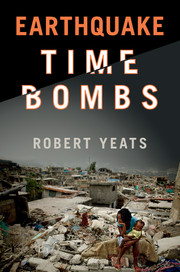Book contents
- Frontmatter
- Contents
- Acknowledgments
- Why this book?
- PART I EARTHQUAKES, DEEP TIME, AND THE POPULATION EXPLOSION
- 1 Plate tectonics and why we have earthquakes
- 2 An earthquake primer
- 3 Deep time
- 4 When's the next Big One?
- 5 Population explosion and increased earthquake risk to megacities
- PART II EARTHQUAKE TIME BOMBS
- PART III SUMMARY AND RECOMMENDATIONS
- References
- Index
5 - Population explosion and increased earthquake risk to megacities
from PART I - EARTHQUAKES, DEEP TIME, AND THE POPULATION EXPLOSION
Published online by Cambridge University Press: 05 November 2015
- Frontmatter
- Contents
- Acknowledgments
- Why this book?
- PART I EARTHQUAKES, DEEP TIME, AND THE POPULATION EXPLOSION
- 1 Plate tectonics and why we have earthquakes
- 2 An earthquake primer
- 3 Deep time
- 4 When's the next Big One?
- 5 Population explosion and increased earthquake risk to megacities
- PART II EARTHQUAKE TIME BOMBS
- PART III SUMMARY AND RECOMMENDATIONS
- References
- Index
Summary
INTRODUCTION
Because of plate tectonics, the Earth has been subjected to earthquakes for millions of years. However, in terms of lives lost, the past is not the key to the future. It is only in the last two centuries that Earth's population has been measured in the billions, and the additional people have become concentrated in crowded cities. Most of us are aware of the effects of increased population on the world food supply and on environmental pollution, including greenhouse gases and dirty water. But the unprecedented migration to cities places millions of people at grave risk from earthquakes.
THE POPULATION EXPLOSION
Ten thousand years ago, the world was inhabited by between one million and ten million people (Figure 5.1). Humans were beginning to evolve from primitive hunter-gatherers to farmers and herders, starting in the Middle East and Egypt. Later, the first cities were organized, such as the desert city of Jericho, founded many thousands of years ago near a spring close to the Dead Sea fault. Other cities grew in Mesopotamia, Egypt, Palestine, Greece, India, central China, Mexico, and Peru, and writing and culture developed. The social organization provided by living in cities led to people living in houses rather than caves. The increased availability of shelter and food from nearby farms gave people leisure time for writing and art. The cities flourished.
Hunter-gatherers had to worry about being attacked by wolves and tigers, but the growing cities, because of the problem of many people living close together in unhealthy surroundings, had to cope with disease, with the most famous example being the Black Death plague of medieval Europe. Sanitation, including clean water, was poor to nonexistent, and disease, together with wars, had the effect of keeping the population in check. A modern example of this condition is found among the isolated Kyrgyz nomads of the Wakhan corridor of easternmost Afghanistan: no roads, no government services, no medical care, and a high death rate, particularly among their children. Because of their isolation from the rest of Afghanistan, the Kyrgyz tribes of the Wakhan corridor have not increased in numbers, as documented in a recent article in National Geographic Magazine (Finkel and Paley, 2013).
- Type
- Chapter
- Information
- Earthquake Time Bombs , pp. 63 - 76Publisher: Cambridge University PressPrint publication year: 2015



